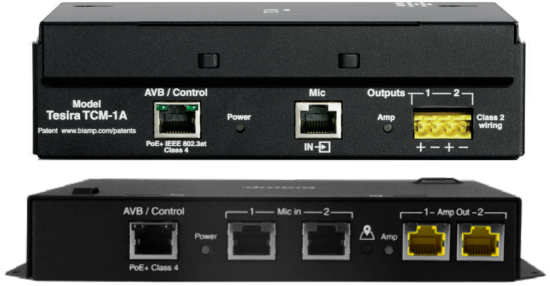Burst Mode in Biamp PoE+ amplifiers
Biamp's AMP-450P, AMP450BP, TCM-XA, and TCM-1A PoE+ amplifiers feature our unique patent-pending "Burst Power" power supply architecture.
These PoE+ amplifiers use Burst Power reserves when the instantaneous output power needs go above the amp’s continuous power capability. This unique approach to the power supply architecture allows the amplifier to maintain perceived audio output levels far beyond conventional PoE / PoE+ amplifier designs.
Models
The Tesira AMP-450P and AMP-450BP are 4-channel PoE+ conferencing amplifiers.
- Four channels: 50W (4Ω) or 30W (8Ω) Burst Power per channel
- Software-selectable power vs. channel count:
-
3W continuous power per channel with 4 channels used (4Ω or 8Ω)
-
7W continuous power per channel with 2 channels used (4Ω or 8Ω)
-
15W continuous power per channel with 1 channel used (4Ω or 8Ω)
-
- Class D amplifier topology with internal limiter function
-
Limiting prevents accidental shutdowns due to overtaxing the PoE+ switch port
- Plenum rated box, suitable for use in air handling spaces, tested to UL 2043
The Tesira TCM-1A and TCM-XA ceiling mic and amplifier offering have a 2-channel PoE+ conferencing amplifier.
- Two channels: 40W (4Ω) or 30W (8Ω) Burst Power per channel
- Software-selectable power vs. channel count:
-
4W continuous power per channel with 2 channels used (4Ω or 8Ω)
-
8W continuous power per channel with 1 channel used (4Ω or 8Ω)
-
- Class D amplifier topology with internal limiter function
-
Limiting prevents accidental shutdowns due to overtaxing the PoE+ switch port
- Plenum rated box, suitable for use in air handling spaces, tested to UL 2043
 AMP-450BP and TCM-XA use category cable for connections to Biamp Desono loudspeakers. These can be connected to any speaker requiring a bare wire or Phoenix style termination with the Biamp CCA (Category Cable Adapter) connector.
AMP-450BP and TCM-XA use category cable for connections to Biamp Desono loudspeakers. These can be connected to any speaker requiring a bare wire or Phoenix style termination with the Biamp CCA (Category Cable Adapter) connector.
AMP-450P and TCM-1A use 4-pin male Phoenix output connectors. CCA can also be used to connect the 4-pin male Phoenix output connectors on the TCM-1A and AMP-450P to a category cable.
One Biamp CCA is required per amp channel.
Amplifier specifications
All audio content can essentially be reduced to 2 component types for amplification purposes. There is continuous program information, which maintains a fairly steady RMS output level over time, and peak program information, which is caused by nearly instantaneous transients or spikes in the material. Transient levels vary by the type of content but for most applications the peaks can be 12-24dB above the continuous level. Biamp’s Burst Power mode handles these transient peaks.
Burst Power
Biamp has developed a new patent-pending PoE+ power supply supporting Burst Power mode.
The strength of Biamp's new Burst Power mode lies in several new technologies working seamlessly together to allow greater peak output than conventional PoE / PoE+ amplifier designs.
Burst Power mode allows Biamp to simultaneously support up to 50W of peak power on 4 channels on our AMP-450P/BP PoE+ amplifier.
Continuous power
The continuous power rating of an amplifier describes the ability of the amp to provide a constant output over time. This differs from peak power rating or Biamp’s Burst Power which are for instantaneous (very short time duration) events.
Our continuous power ratings may seem conservative but rigorous testing has proven that they supply more than enough power for conference system reinforcement.
For other applications, requiring even higher power, Biamp offers the Tesira-AMP and TesiraXEL amplifier series.
Amplifier Operation
In normal use the amplifier will run primarily in the continuous rated power range, with peaks or transients occasionally spiking and utilizing the greater headroom of the Burst Power mode. This is the proper use mode for the amplifier.
You will want to place a compressor block in your signal chain and tune it to soften the onset of limiting if you are regularly activating the Burst Power mode.
In some cases where volumes are run to sustained high levels, average program levels may exceed the continuous power rating of the amplifier. This is not considered “normal” usage for a properly spec’ed system.
In these cases, the amplifier will eventually draw down the Burst Power reserves until they are empty - but this should never be a showstopper.
If reserves are depleted the Biamp amplifier will actively engage limiters to "ride" the input volume and maintain the maximum sustainable continuous output level without exceeding the PoE+ port power rating. During these intensive periods headroom is diminished to maintain perceived audio output levels.
Limiting will prevent the amplifier output stage from clipping the input signal. The show will go on, and as the levels return to normal the output headroom will return to normal as well.
Some PoE-powered amplifiers will simply over-run the current rating of the switch port, causing the network switch itself to shut down the power to the port to prevent damage - of course this results in the amplifier losing power and audio stopping altogether! In that scenario there is no feedback to the user to alert them to why the amp stopped working, audio just mysteriously stops.
Biamp avoids this issue by automatically limiting its input power draw. The Biamp amplifier intelligently manages its use of the 25.5W PoE+ power available from the switch port so we will never be shut off for overtaxing a port. (Note that we cannot know the overall PoE+ power budget of the switch, that must be accounted for appropriately in the network design.)
Amplifier Application
How loud is the rated continuous power really going to be?
Let's calculate using a single speaker in a free-field with a sensitivity of 90dB-SPL @1W/1m:
- at 3W it produces 94.7dB-SPL continuous at 1 meter (AMP-450P/BP with 4 channels driven)
- at 4W it produces 96dB-SPL continuous at 1 meter (TCM-XA/1A with 2 channels driven)
The free-field calculation for the 4W TCM-XA/1A with listeners at 2 meters (6.5 feet) from the speaker predicts the volume will be about 90dB-SPL continuous, and for listeners 4 meters (13.1 feet) away from the speaker the volume is about 84dB-SPL RMS continuous. (Both positions will be approximately 1.5dB-SPL lower for the 3W AMP-450P/BP using 4 channels.)
There are additional electrical and acoustic gains per doubling of amplifier channels powering speakers in a common space, as with a 4-channel AMP-450P/BP versus a 2-channel TCM-XA/1A, these are not calculated here.
If you are not using all channels on the amplifier the output power ratings increase. Let's again calculate using a single speaker in a free-field rated 90dB-SPL (1W, 1m):
- at 7W it produces 98.4dB-SPL continuous at 1 meter (AMP-450P/BP with 2 channels driven)
- at 8W it produces 99dB-SPL continuous at 1 meter (TCM-XA/1A with 1 channel driven)
- at 15W it produces 101.7dB-SPL continuous at 1 meter (AMP-450P/BP with 1 channel driven)
These are not the Burst Power mode levels being shown in the calculations above, these are continuous power. Burst Power mode gives you headroom above the continuous rating.
Get your SPL meter and try these levels in a conference room, they are really loud! Far louder than anyone would want in the average conference room. Typical continuous speech volume in a conference room environment is often around 65-70dB-SPL. Continuous pink noise at 80dB-SPL is a common commissioning benchmark.
You can run these calculations for yourself using our Amplifier Power Calculator.
Measurement methods
Biamp tests amp power ratings using the internationally recognized ANSI/CTA-2006-B measurement standard for amplification. No smoke and mirrors involved.
PoE+
The AMP-450P, AMP-450BP, TCM-XA, and TCM-1A can be powered by either inline PoE+ injectors or PoE+ capable switches. Biamp's PoE+ amps require IEEE 802.3at Type 2, Class 4 PoE+.

